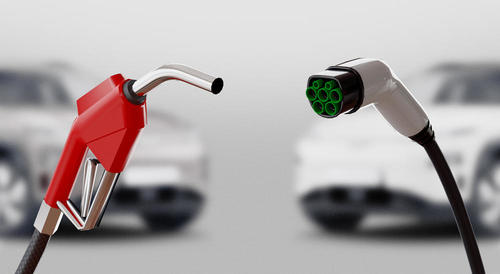The price of carbon characterizing the trade-off between conventional and battery electric cars in Norway exceeds € 1370 per ton of CO2. As compared to the price of emission allowances in the European cap-and-trade system, the price paid by Norwegian motorists is 40 to 50 times higher.
The rapid market uptake of battery (BEV) and plug-in hybrid (PHEV) electric vehicles in Norway is unparalleled. Their sales have grown almost continuously since 2010, at the expense of gasoline and diesel cars. In 2020, the BEV and PHEV market shares were 52.3 and 20.4 percent, respectively.
In a recent paper, The Norwegian Vehicle Electrification Policy and Its Implicit Price of Carbon, the fiscal policy instruments behind this development are examined. In essence, the Norwegian policy consists in taxing internal combustion engine vehicles rather than subsidizing electric ones.
There are 14 different fiscal incentives in place bearing on vehicles, fuel or road use. All of them are in some way CO2-differentiated. Zero exhaust emission vehicles (ZEVs), i.e. battery and fuel cell electric cars, are wholly or partially exempt from the first nine of these:
- Graduated, one-off registration tax on passenger cars and light commercial vehicles LCVs, with ZEVs fully exempt
- Reregistration tax on second-hand sales of passenger cars and LCVs, with ZEVs fully exempt
- Annual circulation (ownership) tax on passenger cars and LCVs, with ZEVs fully exempt
- Fuel tax, not applicable to ZEVs
- Road toll, with ZEVs fully or partially exempt
- Ferry fares, with strongly reduced rates for ZEVs
- Public parking fees, often with full exemption for ZEVs
- Income tax on private use of company cars, with lower rates for ZEVs
- Value added tax (VAT), with ZEVs fully exempt
- Weight and Euro-class-graduated annual ownership tax on heavy-duty freight vehicles
- Government support for fast charging and hydrogen refueling facilities
- Free recharging of BEVs at public parking lots
- Subsidy on new battery or fuel cell electric light commercial vehicles
- Subsidies on zero emission heavy-duty vehicles and machinery
In the tradition of positive economics, the paper derives the price of carbon implicit in each of these policy instruments and in the total package of taxes and subsidies. The price of carbon characterizing the trade-off between conventional and battery electric passenger cars in Norway as of 2019 exceeds € 1370 per ton of CO2. For light and heavy-duty commercial vehicles, the corresponding prices have been conservatively estimated at € 640 and € 200 per ton of CO2, respectively.
In addition, the penalty incurred by automakers not meeting their 2020/2021 target under EU Regulation 2019/631 corresponds to a carbon price of the order of € 340 per ton of CO2. As compared to the price of emission allowances in the European cap-and-trade system, the price of carbon paid by automakers and Norwegian motorists is one or two orders of magnitude higher.
The paper, now published in Sustainability, has been authored by Lasse Fridstrøm, Senior Research Economist at the Institute of Transport Economics (TØI) in Oslo. Funding from the Norwegian Public Roads Administration and from the Research Council of Norway is gratefully acknowledged.






